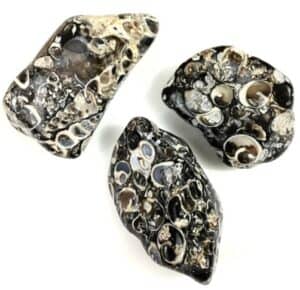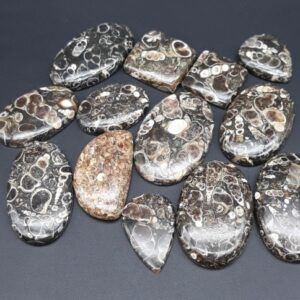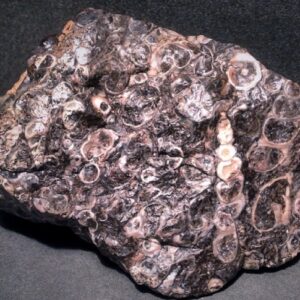Turritella Agate is an organic gem material that was incorrectly named decades ago. A christener discovered the material and thought that the incredible spiral-shaped gastropod (snail) fossils entombed within the stone were members of the Turritell genus. That, my friends, was a simple mistake because instead, what he found were fossils of freshwater snails, Elimia tenera – a member of the Pleuroceridae family.
So, the correct naming convention should be “Pleuroceridae Agate” but if you go to a rock and mineral show and ask one of the dealers you’ll receive a weird look or “Never heard of it”.
Types of Turritella Agate
Turritell Agate hails from the well-known Green River Formation in Wyoming, where numerous types of fossils are still being found today. This type of Agate is comprised of shells from freshwater snails and a grayish-brown to almost black Chalcedony. It’s a favorite amongst rockhounds, lapidary artists, and fossil collectors.
Turritella Agates have been collected and cut into cabochons by the lapidary community for over 50 years. Whether you’re a rockhound or fossil collector, this half-agate, half-fossil rock is pretty cool to collect and is perfect for jewelry.

Turritella Agate Wyoming
Fossils are found throughout the world, but finding large deposits is relatively rare. Some of the best deposits are found in protected areas, and the fossils are left where they lie. While marine fossils are relatively common, Turritella Agates are found exclusively in Wyoming. These translucent to semi-transparent fossiliferous Agates are located in the Green River Formation in Wyoming. You can try looking elsewhere, but you would be wasting your time.

Can Turritella Agate Go In Water?
Yes, Turritella agate is safe to submerge in water. If you have a piece of rough and looking to clean it with soap and water then you have nothing to worry about as long as the matrix is a dark brown.
If the matrix on your Turritella Agate is grey or greying in color then you should proceed with caution because this material is porous and the water or cleaning solution might affect its durability. I’d recommend testing a smaller piece or a piece that you’re good with damaging.
Turritella Agate registers a 7 on the Mohs hardness but the lighter grey has porosity issues.
If you plan on soaking the material then you really need to make sure the matrix is dark or very dark in color. Once again, you will have issues with the grey matrix the reason being the water and cleaning solution will force its way into cracks. Add in the fact you’ll probably scrub it with a brush and you have a perfect environment for the grey material to start breaking off.
Again, Turritella Agates are safe to go in the water, and there shouldn’t be any damage. However, it’s best to avoid leaving them to soak in the water for too long.

Where Is Turritella Agate Found?
So far, there is only one place on the planet where Turritella Agates can be found, and that’s in The Green River Formation which is located in Wyoming. If you don’t want to dig your Turritella Agate then you’ll find these cool-looking stones at rock and mineral shows or online.
The Green River Formation or Lake System is made up of Fossil Lake, Lake Unita, and Lake Gosiute, covering parts of modern-day Wyoming, Colorado, and Utah. These incredible lakes persisted for about 12 million years, which is longer than most known lake systems on the planet. However, if you’re on the hunt for Turritella, stick around the Wyoming region, and you’ll have more luck.
When purchasing Turritella Agates, it’s best to find pieces with a dark-colored matrix because it holds up better over time. If you come across pieces with a light gray matrix then you need to know this material seems to be more porous, has a tendency to crumble, and if you polish the stone then it will have heavy pitting on the surface.
- Identify Enstatite - March 12, 2024
- Identify Cerussite - March 3, 2024
- Identify Bytownite - February 18, 2024
